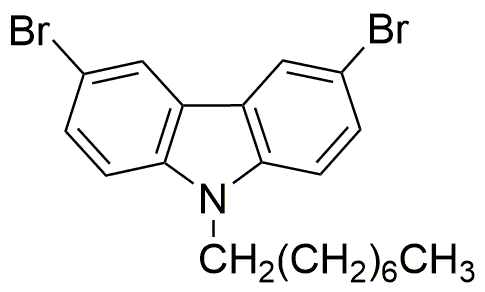3,6-Dibromo-9-n-octylcarbazole is widely utilized in research focused on:
- Organic Electronics: This compound is used in the development of organic light-emitting diodes (OLEDs), enhancing the efficiency and color purity of displays in televisions and smartphones.
- Photovoltaic Cells: It serves as a material in organic solar cells, contributing to improved energy conversion efficiency, which is crucial for sustainable energy solutions.
- Fluorescent Sensors: The compound is employed in creating fluorescent sensors for detecting environmental pollutants, aiding in environmental monitoring and protection.
- Polymer Chemistry: It acts as a building block for synthesizing advanced polymers, which are used in coatings and adhesives, providing enhanced durability and performance.
- Biological Research: This chemical is utilized in studies investigating its potential as a therapeutic agent, particularly in cancer research, due to its unique structural properties.
Información general
Propiedades
Seguridad y normativas
Aplicaciones
3,6-Dibromo-9-n-octylcarbazole is widely utilized in research focused on:
- Organic Electronics: This compound is used in the development of organic light-emitting diodes (OLEDs), enhancing the efficiency and color purity of displays in televisions and smartphones.
- Photovoltaic Cells: It serves as a material in organic solar cells, contributing to improved energy conversion efficiency, which is crucial for sustainable energy solutions.
- Fluorescent Sensors: The compound is employed in creating fluorescent sensors for detecting environmental pollutants, aiding in environmental monitoring and protection.
- Polymer Chemistry: It acts as a building block for synthesizing advanced polymers, which are used in coatings and adhesives, providing enhanced durability and performance.
- Biological Research: This chemical is utilized in studies investigating its potential as a therapeutic agent, particularly in cancer research, due to its unique structural properties.
Documentos
Hojas de datos de seguridad (HDS)
La SDS proporciona información de seguridad completa sobre la manipulación, el almacenamiento y la eliminación del producto.
Especificación del producto (PS)
La PS proporciona un desglose completo de las propiedades del producto, incluida la composición química, el estado físico, la pureza y los requisitos de almacenamiento. También detalla los rangos de calidad aceptables y las aplicaciones previstas del producto.
Certificados de análisis (COA)
Busque certificados de análisis (COA) ingresando el número de lote del producto. Los números de lote y de partida se pueden encontrar en la etiqueta de un producto después de las palabras "Lote" o "Lote".
Número de catálogo
Número de lote/lote
Certificados de origen (COO)
Este certificado de origen confirma el país en el que se fabricó el producto y también detalla los materiales y componentes utilizados en él y si se deriva de fuentes naturales, sintéticas u otras fuentes específicas. Este certificado puede ser necesario para cumplir con las normativas aduaneras, comerciales y regulatorias.
Número de catálogo
Número de lote/lote
Hojas de datos de seguridad (HDS)
La SDS proporciona información de seguridad completa sobre la manipulación, el almacenamiento y la eliminación del producto.
DownloadEspecificación del producto (PS)
La PS proporciona un desglose completo de las propiedades del producto, incluida la composición química, el estado físico, la pureza y los requisitos de almacenamiento. También detalla los rangos de calidad aceptables y las aplicaciones previstas del producto.
DownloadCertificados de análisis (COA)
Busque certificados de análisis (COA) ingresando el número de lote del producto. Los números de lote y de partida se pueden encontrar en la etiqueta de un producto después de las palabras "Lote" o "Lote".
Número de catálogo
Número de lote/lote
Certificados de origen (COO)
Este certificado de origen confirma el país en el que se fabricó el producto y también detalla los materiales y componentes utilizados en él y si se deriva de fuentes naturales, sintéticas u otras fuentes específicas. Este certificado puede ser necesario para cumplir con las normativas aduaneras, comerciales y regulatorias.


